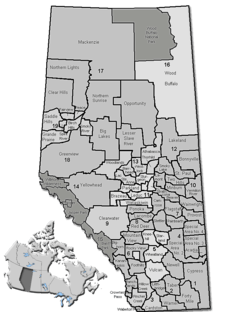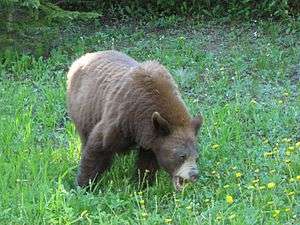Waterton Lakes National Park
| Waterton Lakes National Park | |
|---|---|
|
IUCN category II (national park) | |
|
Upper Waterton Lake | |
 Waterton Lakes National Park Location | |
| Location | Alberta, Canada |
| Nearest city | Pincher Creek |
| Coordinates | 49°02′45″N 113°54′55″W / 49.04583°N 113.91528°WCoordinates: 49°02′45″N 113°54′55″W / 49.04583°N 113.91528°W |
| Area | 505 km2 (195 sq mi) |
| Established |
1895 (national park) 1979 (biosphere reserve) 1995 (world heritage site) |
| Visitors | 402,542 (in 2012/13[1]) |
| Governing body | I.D. Council, Parks Canada |
| World Heritage Site | 354 |
| Improvement District No. 4 | |
|---|---|
| Improvement district | |
 Location of Waterton Lakes National Park in Alberta | |
| Coordinates: 49°02′45″N 113°54′55″W / 49.04583°N 113.91528°W | |
| Country |
|
| Province |
|
| Region | Southern Alberta |
| Census division | No. 3 |
| Government[2] | |
| • Governing body | I.D. 4 Council |
| • Chair | Brian Reeves |
| • CAO | J. Scott Barton |
| Area[3] | |
| • Total | 480.58 km2 (185.55 sq mi) |
| Population (2011)[3] | |
| • Total | 88 |
| • Density | 0.2/km2 (0.5/sq mi) |
| • Dwellings | 167 |
| Time zone | MST (UTC-7) |
| • Summer (DST) | MDT (UTC-6) |
| Website | Parks Canada |
Waterton Lakes National Park is a national park located in the southwest corner of Alberta, Canada, and borders Glacier National Park in Montana, United States. Waterton was Canada's fourth national park, formed in 1895 and named after Waterton Lake, in turn after the Victorian naturalist and conservationist Charles Waterton. The park contains 505 km2 (195 sq mi) of rugged mountains and wilderness.
Operated by Parks Canada, Waterton is open all year, but the main tourist season is during July and August. The only commercial facilities available within the park are located at the Waterton Park townsite. The park ranges in elevation from 1,290 metres (4,232 ft) at the townsite to 2,910 m (9,547 ft) at Mount Blakiston. It offers many scenic trails, including Crypt Lake trail. In 2012/2013, Waterton Lakes National Park had 402,542 visitors.[1]
The park was the subject of a short film in 2011's National Parks Project, directed by Peter Lynch and scored by Cadence Weapon, Laura Barrett and Mark Hamilton.
History
In 1932, Waterton-Glacier International Peace Park was formed from Waterton and Glacier. It was dedicated to world peace by Sir Charles Arthur Mander on behalf of Rotary International. Although the park has a lot of diversity for its size, the main highlight is the Waterton lakes—the deepest in the Canadian Rockies—overlooked by the historic Prince of Wales Hotel National Historic Site.
Fauna
Animals that inhabit this national park include wolverines, bighorn sheep, bald eagles, white-tailed deer, mule deer, mountain goats, elk, moose, foxes, wolves, coyotes, beavers, river otters, cougars, lynxes, bobcats, snowshoe hares, pikas, hoary marmots, grizzly bears and black bears.
Biosphere Reserve
In 1979, Waterton and bordering Glacier National park in the US were designated as World Biosphere reserves, preserving mountains, prairie, lakes and freshwater wetlands ecosystems. Habitats represented in the parks' range include: prairie grasslands, aspen grove forests, alpine tundra/high meadows, lower subalpine forests, deciduous and coniferous forests.[4]
World Heritage Site
The park is part of the Waterton-Glacier International Peace Park, designated as World Heritage Site in 1995 for their distinctive climate, physiographic setting, mountain-prairie interface, and tri-ocean hydrographical divide. They are areas of significant scenic values with abundant and diverse flora and fauna.[5]
Photo gallery

- View from top of Summit Trail
 Panorama taken from Prince of Wales hotel looking south
Panorama taken from Prince of Wales hotel looking south 49th parallel at Waterton Lake
49th parallel at Waterton Lake Cameron Falls
Cameron Falls- Red Rock Canyon
 Waterton Park townsite campground
Waterton Park townsite campground- South Beach of Waterton Park townsite
- Blakiston Falls (upper)
 Cinnamon-coloured Black Bear eating dandelions, in Akamina Parkway.
Cinnamon-coloured Black Bear eating dandelions, in Akamina Parkway. View of the mountains surrounding the Waterton Lake.
View of the mountains surrounding the Waterton Lake.
 Castilleja miniata Indian Paintbrush on the Bears Hump
Castilleja miniata Indian Paintbrush on the Bears Hump
| Wikimedia Commons has media related to Waterton Lakes National Park. |
See also
- List of National Parks of Canada
- List of parks in Alberta
- List of trails in Alberta
- List of mountains in Alberta
- List of waterfalls of Alberta
References
- 1 2 "Parks Canada Attendance 2007-08 to 2012-13" (PDF). Parks Canada. July 31, 2013. p. 2. Retrieved May 29, 2014.
- ↑ "Municipal Officials Search". Alberta Municipal Affairs. November 18, 2016. Retrieved November 21, 2016.
- 1 2 "Population and dwelling counts, for Canada, provinces and territories, and census subdivisions (municipalities), 2011 and 2006 censuses (Alberta)". Statistics Canada. January 30, 2013. Retrieved June 16, 2013.
- ↑ UNESCO - Park description at UNESCO World Biosphere Reserve
- ↑ UNESCO - Park description at UNESCO World Heritage
External links
| Wikivoyage has a travel guide for Waterton Lakes National Park. |
- Waterton Lakes National Park (Parks Canada)
- Pure Experience: Waterton Lakes National Park (Travel Alberta)

